|
A WHOLE NEW BALL GAME
Some people – far less perceptive
and intelligent people than you, the good and wise viewers of Retro
Gamer – always say the same thing whenever anyone makes a videogame
about pinball. “But what’s the point of making a pinball
videogame?”, they moan. “Pinball’s all about the physical
sensations, and shoving the machine around in the pub and stuff.”
These people are cretins, of course.
Pinball is simply the mechanical
equivalent of an FPS – hundreds of games use the same basic formula,
the difference between a good and a bad one is all about the level
design, and the key to success is pinpoint shooting. (The Goldeneye
pinball is pretty good, if you’re wondering.) But what happens when
you try to turn other types of videogame into pinball? (Smooth
link. – Ed)
One of the most interesting aspects of
the early videogames was the attempt by publishers to translate the
core aspects of their gameplay to other media. In a previous issue
of RG, for example, we looked at the early-80s board-game versions
of some classics, of which there are far more than most people know
(at least 20, going by the contents of my basement), and the same is
true about pinball. A whole clutch of the iconic videogames from the
Golden Era of the arcades also appeared in pinball form, with
varying degrees of success and faithfulness to their source
material. Tragically, nobody knows anything about them. Bummer.
Wait! I do! (Phew. - Ed)
-----------------------------------------------------------------------------------------------------------
SPACE INVADERS (Bally Midway)
Videogame 1978, pinball 1980
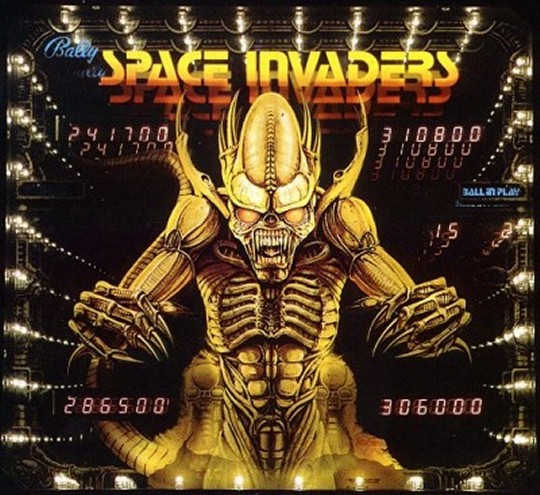
In 1980, videogames were still seen by
some in the arcade business as a flash-in-the-pan phenomenon which
hadn’t yet proved itself to be the long-term successor of pinball.
So when Taito’s seminal Space Invaders took the West by storm as it
had done in Japan, US licensors Bally Midway decided to spin it off
into their more traditional field of expertise, which was pinball.
They even went to the trouble of concocting a story explaining the
Invaders’ journey from screen to table, depicted in a four-page
comic-book section of the lavish flyer.
For some reason, though, in
the process of crossing the arcade divide, Tom-Tosh Nishikado’s
octopus-like space monsters got transformed into creatures uncannily
akin to the terrifying Xenomorph from Alien, and the entire machine
and playfield, while undeniably striking, look far more like the
work of H R Giger than the iconic art of Space Invaders. (Indeed,
Bally Midway were successfully sued over the steal.)
Nothing else from the videogame made it
to the pinball either – no gameplay elements, and an attempt at the
trademark heartbeat sound which would have any doctor rushing the
patient to intensive care with sirens blaring - and generally this
looks for all the world like an Alien pinball that got hastily
rebadged when someone lost the movie licence. Pinball was still
mechanically quite primitive at the time, lacking even such basic
features as ramps (flippers didn’t have the power to get the ball up
them), and all Space Invaders had to work with was a pretty dull
collection of bumpers and targets to light up, with a central
horseshoe loop the closest thing to heady thrills on offer. It
wasn’t an auspicious start for the crossover, but things would
improve pretty soon.
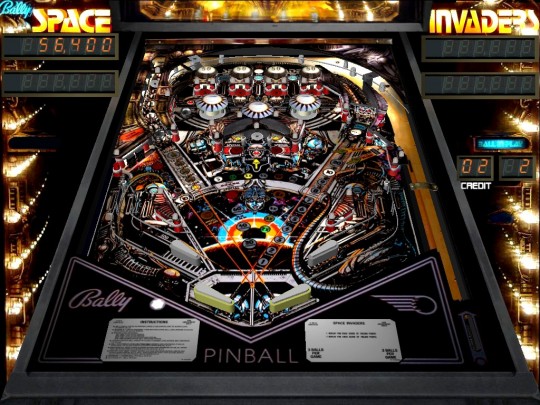
Space Invaders was still
such an enormous name at the time that over 11,000 Invaders
pinball machines were manufactured, a dizzyingly high number in the
world of pinball.
-----------------------------------------------------------------------------------------------------------
DEFENDER (Williams Electronics)
Videogame 1980, pinball 1982
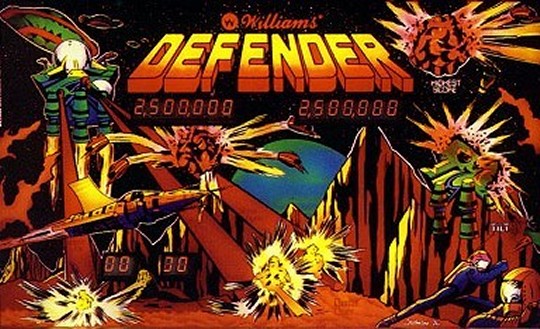
Williams, of course, started life as a
pinball company, and the videogame version of Defender is actually
full of sound effects that originated on Williams pintables. The
game returned the favour by acting as inspiration for a pinball
which, while barely any more technically advanced than Space
Invaders, does an infinitely better job of paying homage to its
parent.
Defender the pinball makes use of
almost every facet of the videogame, with Landers, Mutants, Pods,
Bombers, Baiters and Swarmers all represented in one way or another,
attacking in “waves” just like their onscreen brethren. There’s even
a Smart Bomb (which functions in much the same way as its video
counterpart) and a Reverse button, which ingeniously implements a
pioneering manual version of the outlane “kickback” feature found on
almost every modern pin. The action is fast, furious and nearly as
ferociously difficult as the legendarily challenging videogame
version, and of course it’s got all the same sound effects, since
they were pinball sound effects in the first place.
Just like its arcade daddy, the pinball
Defender is an excellent game even today, but it would shortly have
some serious competition in the videogame-pinball field.
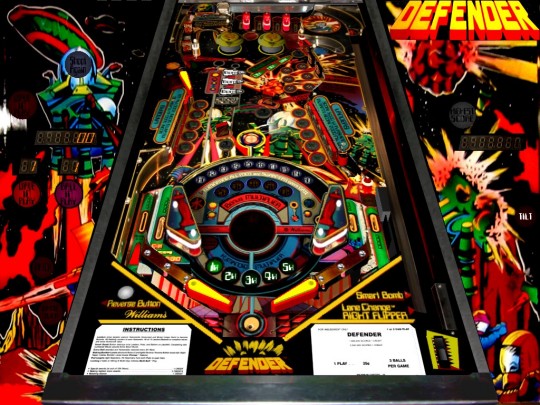
Tragically, only 369 Defender
pinball machines were known to have been made, so you’ll have an
even
harder version tracking down a good-condition one for your game room
than you will a video Defender.
-----------------------------------------------------------------------------------------------------------
MR AND MRS PAC-MAN (Bally Midway)
Videogames 1981, pinball 1982
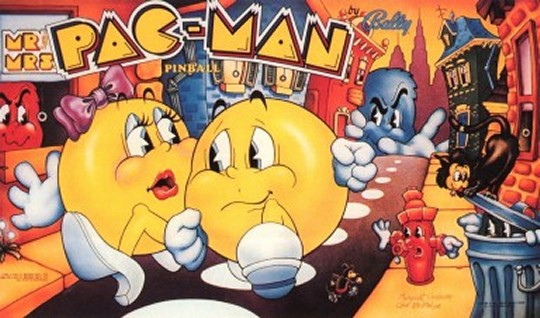
Just a few months after the debut of Ms
Pac-Man in late 1981, the hungry yellow hero followed up on the
story shown in its between-level cutscenes and made an honest woman
of her (the wedding photo is on the front of the machine’s
advertising flyer). Bally celebrated the happy occasion with the
release of this thoroughly splendid and inventive pinball – while
the table itself is still basic 1982 drop-targets-and-bumpers stuff
(except for one of the very first appearances in the modern pinball
era of a plunger skill-shot), the gameplay focuses on making shots
to collect moves for the inspired “Pac-Man” game which takes place
on the light grid in the centre of the table.
Using one flipper to cycle movement
directions and the other to actually move, Pac is chased around the
wall-less “maze” by infamous red ghost Shadow (or, in this case, a
red light), clearing levels by illuminating the whole grid. You can
even earn power-pills on the pinball field, at which point the
booming robotic commentator announces “Pac-Man Aggressive!” and you
can chomp Shadow for bonus points, usually by catching him unawares
and appearing from the other side of the screen, just like using the
original’s escape tunnels. The constant shifting between the pinball
field and the light maze keeps the player on their toes, and both
sections are hard enough to make the game constantly tense and
exciting. Realising that they’d hit onto something good, Bally would
go on later the same year to take it to the next level.
|
LOCAL COLOUR ANECDOTE
Mr And Mrs
Pac-Man is so good that your reporter actually bought
one, leading to a trail of disasters. Still living at
home with my parents in about 1988, I crashed my mum’s
car when I went to view the well-worn machine at a
dealer’s warehouse, narrowly avoiding running over an
old man walking his dog.
When it was
delivered we found it wouldn’t go through any of the
narrow hallways of the house – pinball machines are MUCH
bigger than they seem in the context of arcades or pubs
– so it had to loom enormously in the patio for a few
weeks, working intermittently and constantly bringing
small neighbourhood children to the door, until one
afternoon there was a spectacular bang and flash and
foot-high flames started to lick out of the top, at
which point my parents (by now themselves dubbed Mr And
Mrs Pac-Man by the kids) ran out of patience and I had
to dejectedly sell it back to the dealer on pain of
becoming homeless.
Happily he
only wanted to break it up for parts, so had no use for
the beautiful painted backglass (shown above), which
hangs on my living-room wall to this day.
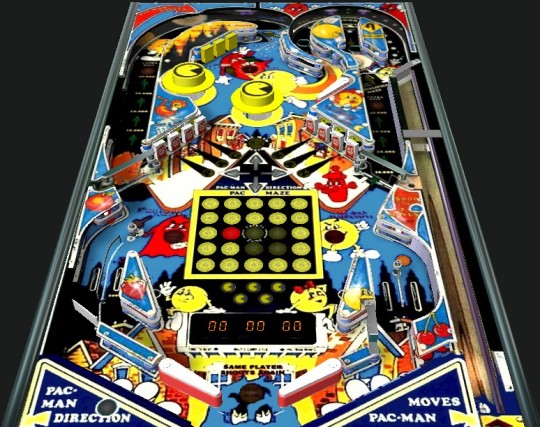
Unlike Defender and Space
Invaders, Mr And Mrs Pac-Man was both
a great game and a big hit, selling more than 10,500
machines.
|
-----------------------------------------------------------------------------------------------------------
BABY PAC-MAN (Bally Midway)
Videogames 1981, pinball 1982
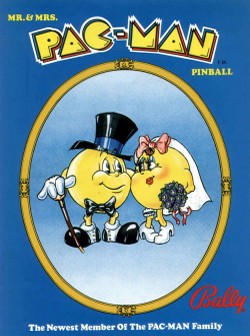 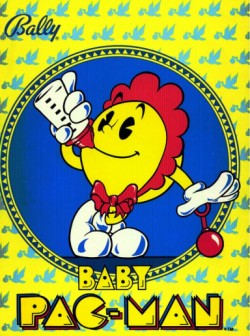
Ah. Now we see why the Pacs got married
so hastily. Just five months after the wedding (Mr and Mrs was
released in May, with Baby following along in October), the
Pac-union produced the wocka-wocka of tiny jaws. (Incidentally, the
third videogame in the series, Jr Pac-Man, showed up in 1983 and
depicted the Pac-sprog as primary-school age, so maybe Pacs just
have an accelerated development and there was nothing indecent going
on all along.)
The accompanying game, however, was
even more startling than Junior’s birth certificate. Baby Pac-Man
was a natural extension of the design of Mr And Mrs Pac-Man, but
this time the maze section was a proper full-blown videogame, with a
joystick attached to the front of the cabinet as well as the
traditional flipper buttons. The pinball field was shorter than
usual, in order to keep the player’s head close to the video screen
sited above it, on which a full-scale Pac-Man game (with several
different mazes) played out.
Hitting pinball targets earns power
pills (poor Baby starts life in the maze with none, but can scarper
through exits at the bottom to get to the pinfield) and speeds up
Baby in the tunnels, and you can only lose lives on the videogame
screen. (There are no outlanes, and letting the ball escape through
the flippers merely dumps Baby back to the video screen, but blocks
the exits to the pinball field until the screen is cleared of dots
or a life is lost.)
Baby Pac-Man is a superb game in its
own right as well as being a very well-balanced hybrid of videogame
and pinball. For this reviewer it’s far more fun than either of its
parents (the ghosts move much more unpredictably so it’s not just
about learning patterns), and the switching back and forth from
video world to physical world gives it a real Tron vibe. It’s a real
high-water mark in imaginative arcade-game design, but it couldn’t
stop pinball from being ever more steadily muscled out of the
amusement halls.
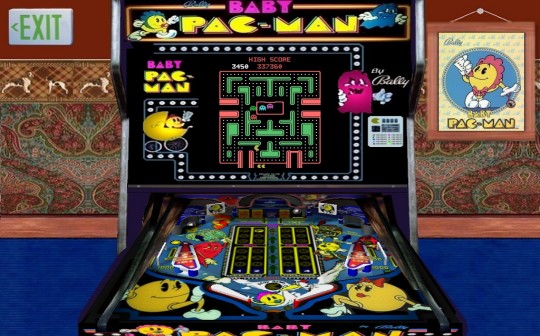
A respectable 7000 units of Baby Pac-Man were sold, but it didn’t
earn well and never made it out of the USA. Bally tried the hybrid
formula once more, with 1984’s Granny And The Gators, but then gave
up.
-----------------------------------------------------------------------------------------------------------
Q*BERT’S QUEST (Gottlieb)
Videogame 1982, pinball 1983
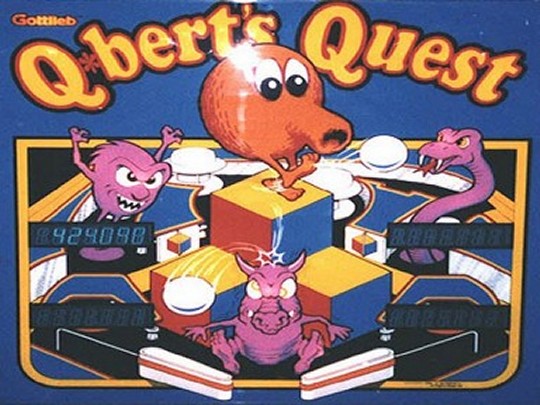
Meanwhile, other companies were trying
different ways of being original in their attempts to bring
videogame properties to the pinball universe. Still restricted to
rudimentary 2D pinball tech, Gottlieb made a very creditable stab at
capturing the pyramid-traversing antics of their legendary orange
foul-mouthed videogame bignose Q*Bert.
A strange, looping table layout coupled
with a pair of very unusual down-facing backwards flippers at the
bottom did a surprisingly good job of simulating Q*Bert’s journeys
up and down his triangular world (the lower flippers, of course,
acting as the flying saucers of the videogame), and lots of voice
samples brought the fruit-coloured schnozzmeister to life. It’s a simple
little game, but still diverting and cute, with the focus on loops
giving it a very different feel to traditional pins of the time.
Clearly, though, videogame publishers were running out of ways to
transfer their successful video creations to the silver-ball field.
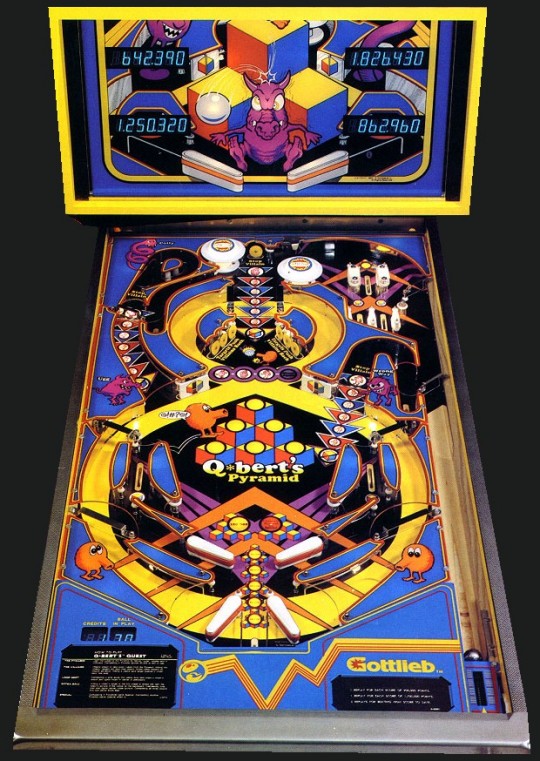
Even in 1983 the simple design
and primary colours of Q*Bert’s Quest looked
a bit childish, and Gottlieb played safe by building fewer than 900
tables.
-----------------------------------------------------------------------------------------------------------
SPY HUNTER (Bally Midway)
Videogame 1983, pinball 1984
The last attempt anyone made in the
videogame-to-pinball genre for almost a decade, and the final one to
be tried with pre-ramps pinball tech, Spy Hunter was a very odd
machine, with an almost unique off-centre playfield arrangement
whereby there were no outlanes on the right, but two on the left.
It’s a spartan sort of game, with almost nothing in common with its
video ancestor except the “Peter Gunn” music, and after this
everyone was clearly put off the whole idea of videogame-to-pinball
ports for several years.
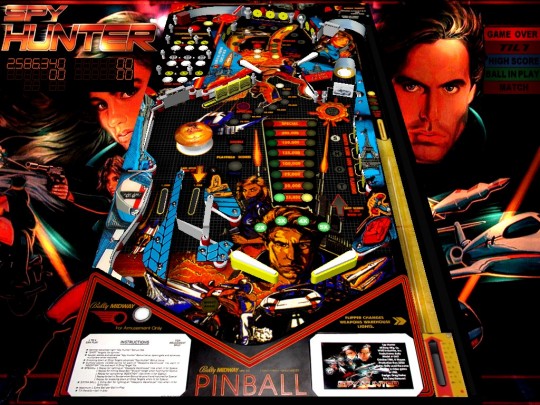
Barely over 2,000 Spy
Hunter pinballs were built, and you’d
probably struggle to find 2,000 people who ever played one.
-----------------------------------------------------------------------------------------------------------
SUPER MARIO BROS (Gottlieb)
Videogame 1985/1990, pinball 1992
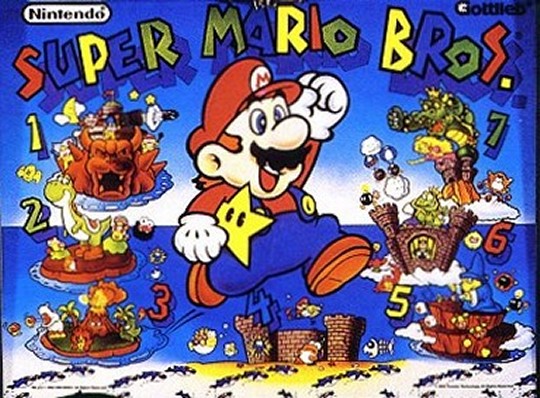
As with so many things in the world of
videogames, it was Mario who came to the rescue of a moribund genre,
with the first videogame pinball of the modern age. Although called
Super Mario Bros, this is really a pinball based on the Super Mario
World universe (as can be seen by the typography, presence of Yoshi
etc), and all the major characters are present and correct in an
accessible and eventful game. The pinball field itself has little
connection gameplay-wise to the original, but there’s a video mode,
where the dot-matrix scoreboard suddenly turns into a scrolling
platform world and the player uses the flipper buttons to send Mario
running and jumping across pits and enemies.
Later the same year Gottlieb released
Super Mario Bros Mushroom World, which was basically the same game
but converted to a ticket-redemption machine and aimed at kids. The
aiming was made easier by the conversion kit, which came with
special adjustable legs enabling the table to be ratcheted down low
enough for five-year-olds to play it.
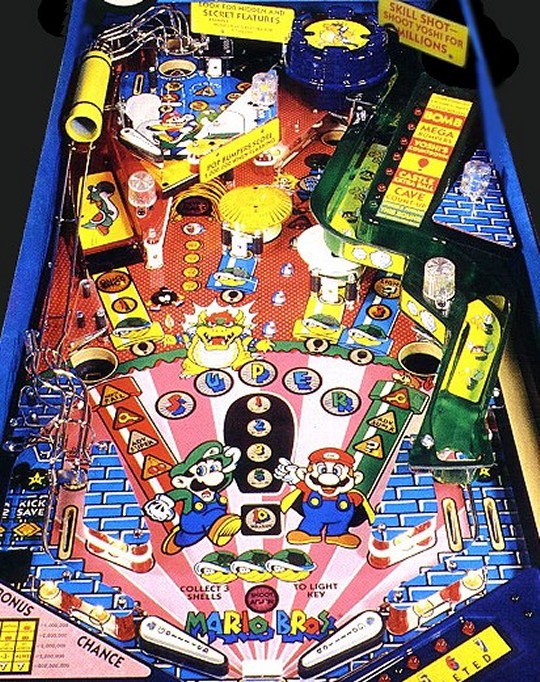
Mario did pretty well in the
pinball world, with the two versions
of the machine combining to sell a little over 5,000 pieces.
-----------------------------------------------------------------------------------------------------------
STREET FIGHTER II CHAMPION EDITION (Gottlieb)
Videogame 1991, pinball 1993
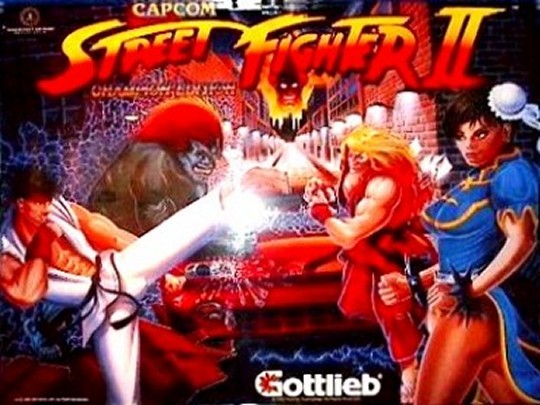
Come to think of it, as well as being a
sort of physical version of an FPS, pinball works well as an analogy
for fighting games too – you can exercise real skill, practicing
over and over until you can hit targets with pixel-perfect,
frame-accurate precision and timing, or you can just bang
frantically on the buttons whenever anything comes near you and hope
you get lucky, which you quite often will.
Anyway, flushed with the relative
success of SMB, Gottlieb wasted little time in bringing another
popular SNES property into pinball arcades. Street Fighter II is a
brilliant pinball, full of little ties to the videogame right down a
perpetually-rotating flipper simulating Chun-Li’s Spinning Bird Kick
and a car-smashing bonus round, played out on a little
mini-playfield complete with red plastic car. Features go off every
10 seconds as you hit various combination shots to tackle all your
favourite SFII combatants, but you’ll have a tough job defeating all
12 opponents to get the Champion Challenge round, where you have to
take down all 12 again in a sort of boss rush to net a 500,000,000
bonus.
It’s not all that uncommon to still come across SFII and SMB
tables now - if you’re somewhere that has pinball at all – and
that’s testament to just how well-designed the games are
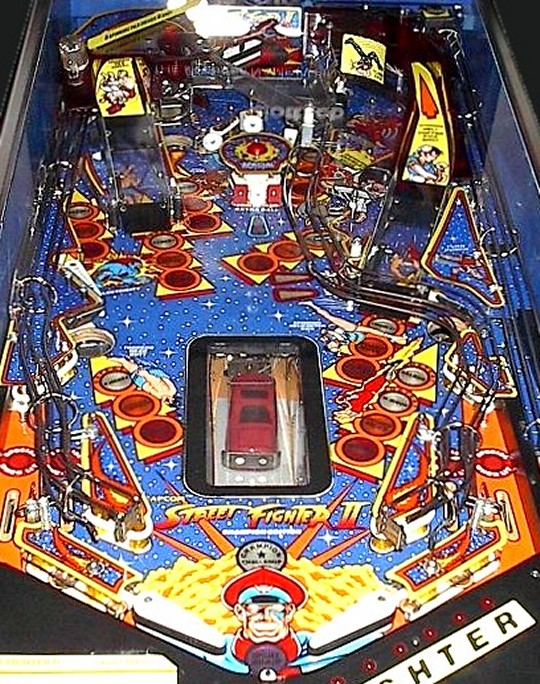
Appropriately for a better game,
Street Fighter II did slightly better than Mario, shifting around
5,500 machines. Oddly, Gottlieb elected not to follow up this
success with any more conversions.
-----------------------------------------------------------------------------------------------------------
ROLLERCOASTER TYCOON (Stern Electronics)
Videogame 1999, pinball 2002
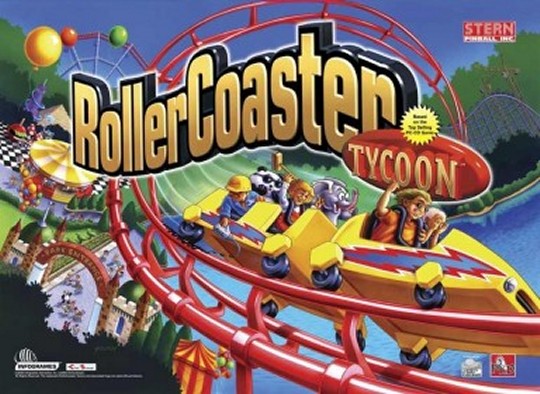
Almost another decade would pass before
anyone would attempt to follow SFII from the videogame world to the
pinball one, and when it did it was one of the least obvious
suspects. Since Stern revived pinball for the new millennium, it’s
drawn on every corner of popular culture for its subject matter
(Playboy, Family Guy, Terminator 3, Monopoly, The Sopranos, Elvis),
and the inclusion of a videogame in this A-list of modern icons is a
sure sign of how mainstream gaming is finally becoming, culturally
speaking. A sim/strategy game is still a heck of a weird choice
(you’d have thought Quake or Half-Life or The Sims, maybe), and
unsurprisingly the only real link to the PC title is that, um, the
ball rides some ramps that are a bit like rollercoasters.
So, er, a bit of a weak ending on this
one. Sorry. Nevertheless, we’ve now learned that videogames have
made a pretty respectable showing in at least two other fields of
gaming (board games and pinball), and that in the hands of skilled
designers it’s possible to translate identifiable gameplay elements
across to what at first glance seems a completely incompatible
discipline. Join us next time, when videogames try expanding even
further to colonise an even more difficult territory – the
world of the fruit machine. Conceal your excitement if you dare.
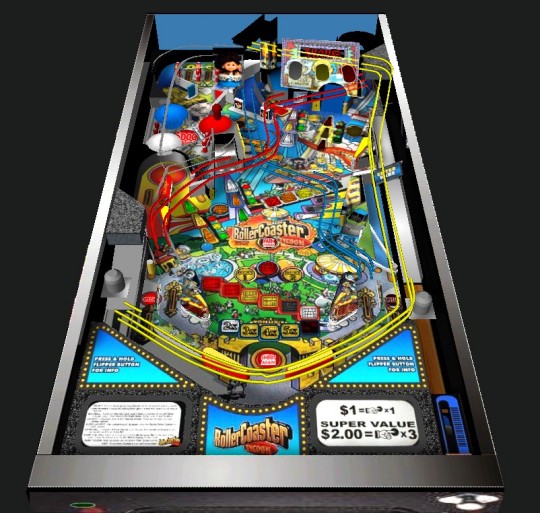
Few sales figures are available
for Stern’s recent line-up, possibly because most of them are still
very much ongoing catalogue items. But estimates for Rollercoaster
Tycoon come in somewhere around the 2,500 area.
|
PLAY IT NOW ON
There
wouldn’t, of course, be much point in telling you about
all these games if there wasn’t some way you could enjoy
them today, and that’s where Visual Pinball comes in. A
superb pinball construction kit for the PC, it can be
used in conjunction with a pinball spinoff of MAME in
order to create extremely authentic emulations of
hundreds of real-life pinball machines. VP can be found
at
www.randydavis.com/vp, while
Visual PinMAME is located at pinmame.retrogames.com.
|
*Thanks to the Internet Pinball Machine
Database for sales stats.
|

